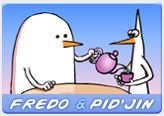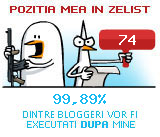Trib. Sat. Companie. Grup de cunostinte. Organizatie. Partid. Haita. Clan. Band of brothers. Toate depind de relationare. Iar relationarea, antropologii o arata, tine de marimea creerului. Iar creerul e bun la facut snitzele, nu?
Joke aside: toate agregarile sociale de mai sus au un punct de convergenta, o marime catre care graviteaza. Undeva in jur de 150, numar care a ajuns sa fie cunoscut drept numarul lui Dunbar.
Dunbar's number is a theoretical cognitive limit to the number of people with whom one can maintain stable social relationships. These are relationships in which an individual knows who each person is, and how each person relates to every other person. Proponents assert that numbers larger than this generally require more restricted rules, laws, and enforced norms to maintain a stable, cohesive group. No precise value has been proposed for Dunbar's number, but a commonly cited approximation is 150.
[...] Beginning with the assumption that the current mean size of the human neocortex had developed about 250,000 years BCE, i.e. during the Pleistocene, Dunbar searched the anthropological and ethnographical literature for census-like group size information for various hunter-gatherer societies, the closest existing approximations to how anthropology reconstructs the Pleistocene societies. Dunbar noted that the groups fell into three categories — small, medium and large, equivalent to bands, cultural lineage groups and tribes — with respective size ranges of 30-50, 100-200 and 500-2500 members each.
Dunbar's surveys of village and tribe sizes also appeared to approximate this predicted value, including 150 as the estimated size of a neolithic farming village; 150 as the splitting point of Hutterite settlements; 200 as the upper bound on the number of academics in a discipline's sub-specialization; 150 as the basic unit size of professional armies in Roman antiquity and in modern times since the 16th century; and notions of appropriate company size.
Interesant si articolul din The Economist, Primates on Facebook, care testeaza teoria lui Dunbar in cazul retelelor de socializare de pe Internet.
THAT Facebook, Twitter and other online social networks will increase the size of human social groups is an obvious hypothesis, given that they reduce a lot of the friction and cost involved in keeping in touch with other people. Once you join and gather your “friends” online, you can share in their lives as recorded by photographs, “status updates” and other titbits, and, with your permission, they can share in yours. Additional friends are free, so why not say the more the merrier?
But perhaps additional friends are not free. Primatologists call at least some of the things that happen on social networks “grooming”. In the wild, grooming is time-consuming and here computerisation certainly helps. But keeping track of who to groom—and why—demands quite a bit of mental computation. You need to remember who is allied with, hostile to, or lusts after whom, and act accordingly. Several years ago, therefore, Robin Dunbar, an anthropologist who now works at Oxford University, concluded that the cognitive power of the brain limits the size of the social network that an individual of any given species can develop. Extrapolating from the brain sizes and social networks of apes, Dr Dunbar suggested that the size of the human brain allows stable networks of about 148. Rounded to 150, this has become famous as “the Dunbar number”.
It's called grooming, mates. And we do it most of the times when we send e-mails, use the Messenger, blog or post some forum comments. It's in our human nature.
Amazon/Microsoft/India/Rusia
Acum 4 ore





1 comentarii:
:)
razboaie duse in haita sau de unii singuri.
saptamana buna :)
Trimiteți un comentariu